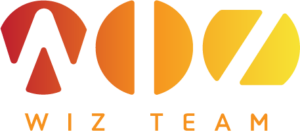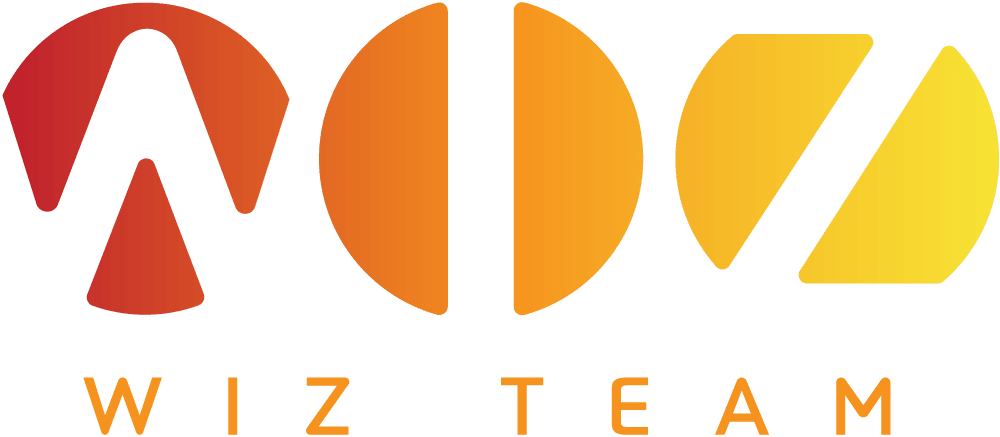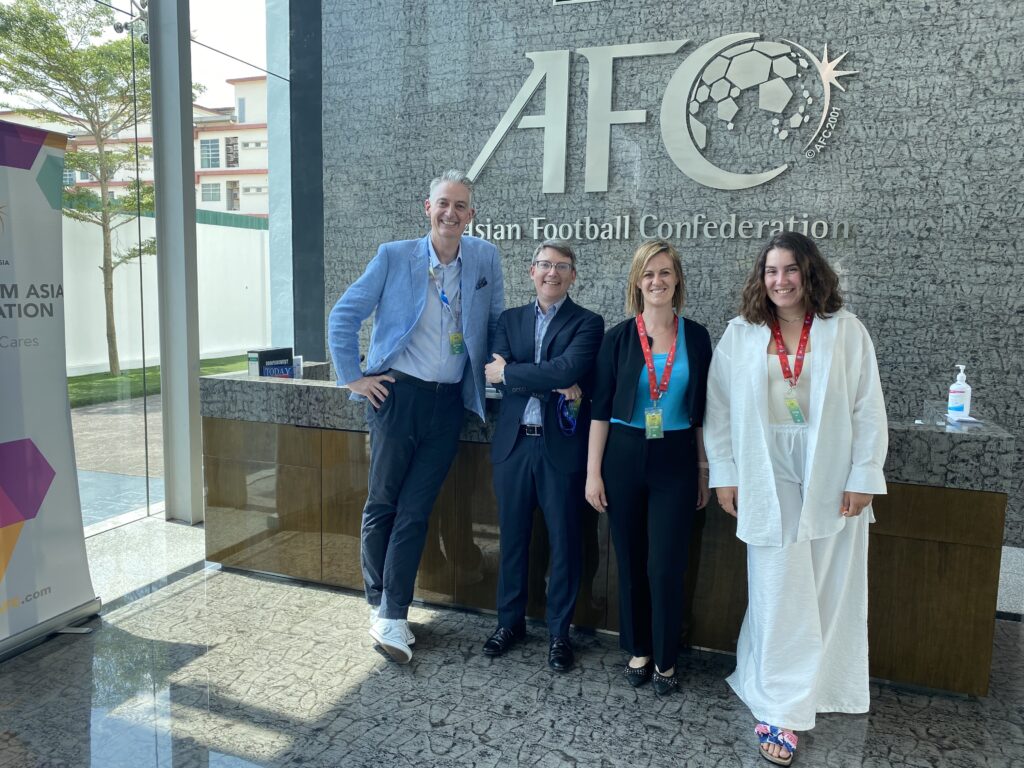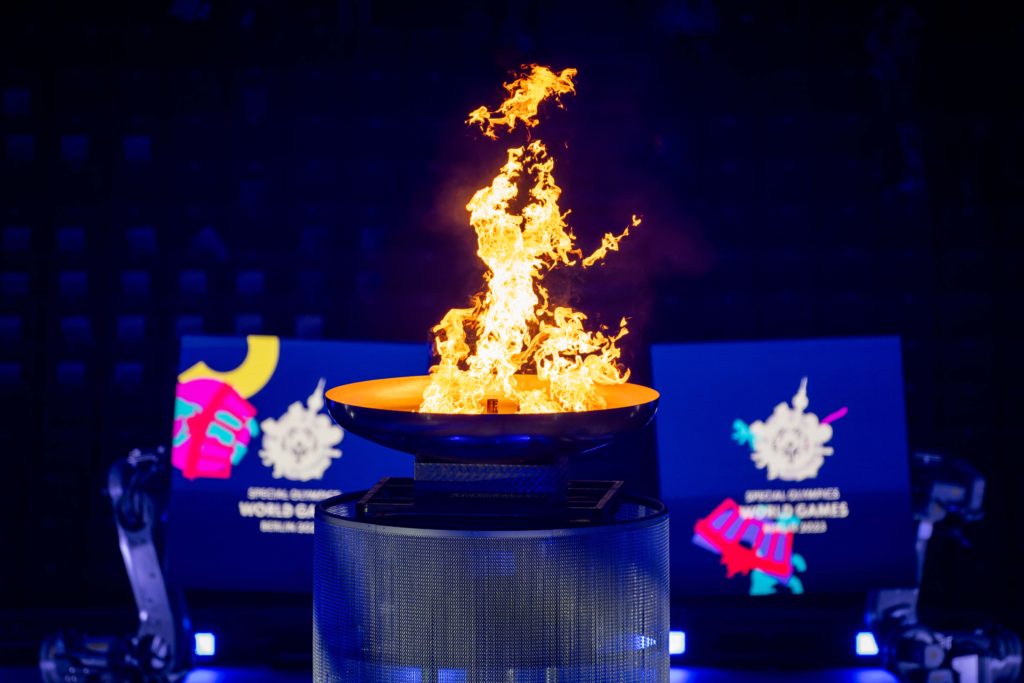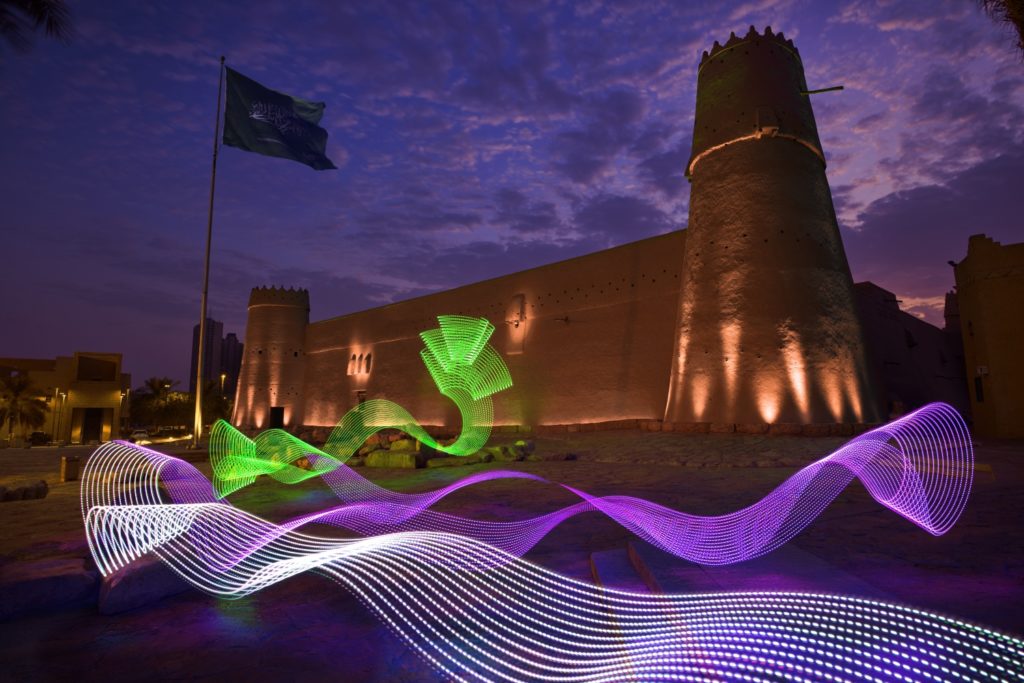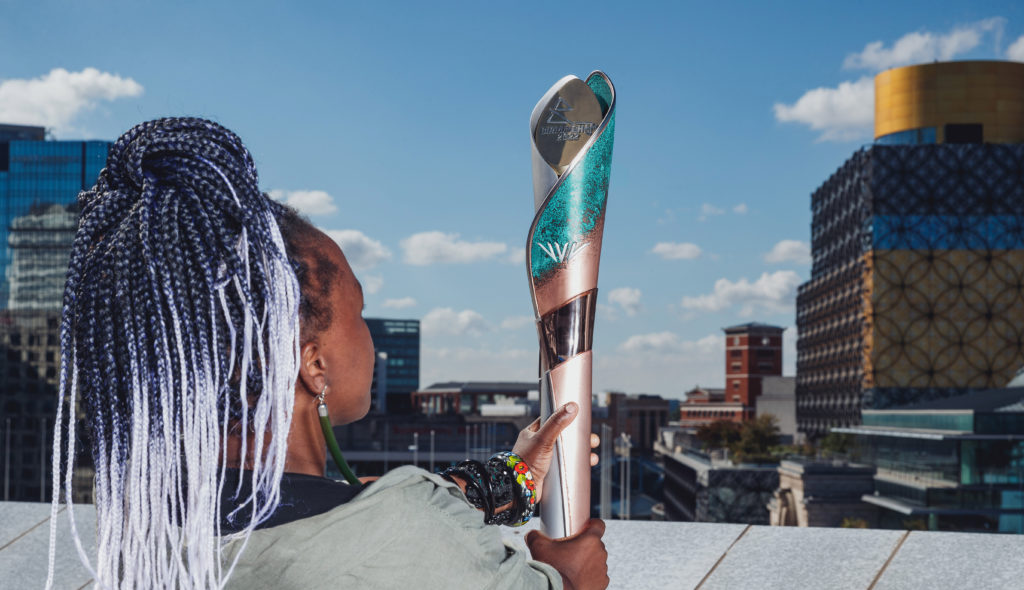You thought you had figured out the hardest part, and that is planning an event, but is it really done until you are creating a real buzz around it?
Planning an event is no small feat, but getting people to notice (and care) is a whole different ball game. That’s where social media steps in as your best friend, guiding you down the path to promoting your event the right way!
But if you consider your event’s social media promotion is done just by posting a few updates, think again. The global virtual events market is expected to hit $340 billion in 2025, and nearly three-quarters of marketers now use livestream video and social platforms to engage audiences before, during, and after their events.
With so many people scrolling, sharing, and signing up all over the internet, promoting your event on social media is the formula for building anticipation, engaging the right people, and making your event stand out in a crowded digital world.
But, before the buzz, before the hashtags, it pays to get crystal clear on two things: what you want to achieve and who you want to reach. Even the best promotion can fall flat if it’s not aimed at the right crowd or built around the right goals.
TL;DR
Defining clear event goals and understanding your target audience is crucial to shaping your promotion strategy.
Use social media to create buzz by sharing engaging content like teasers, behind-the-scenes footage, and interactive posts.
Encourage user-generated content and collaborate with influencers to expand your event’s reach and engagement.
Monitor key metrics, gather feedback, and adjust your approach to continuously improve future event promotions.
1. Define Event Goals and Identify Your Audience
Dialing in your goals and audience is the foundation for every smart move you’ll make on social media, setting your event up for the kind of buzz that gets noticed.
1.1 Be Clear on Your Event Goals (and Why They Matter)
Every event has a purpose. Is this all about spreading awareness? Filling every seat? Building a loyal community? Maybe it’s a mix. Defining your main objectives gives your social media strategy a clear direction.
1.2 Find (and Understand) Your Ideal Audience
Now, let’s talk about who you want in the room, virtual or otherwise. Start by building a picture of your perfect attendee:
What are their interests?
Where do they hang out online?
What kind of content grabs their attention?
This is where audience personas come in handy. The more you know about your target audience’s habits, motivations, and favorite platforms, the easier it is to craft messages that actually resonate and get people excited to join in.
Once you’ve nailed down what your event is all about and who you want to reach, the next step is giving your event a personality that stands out online.
2. Branding Your Event Before Promoting On Social Media
Before you start posting, it’s time to give your event a look and voice that people will recognize and remember. The right branding and tools make every post, story, and share work harder for you.
2.1 Create Cohesive Branding: Visuals, Messaging, and Tone
Choose a color palette, fonts, and logo that consistently reflects your event’s vibe. Use these visuals across all your social media channels, event pages, and promotional materials. Pair your look with messaging that’s clear and inviting.
Decide on the tone of voice. Is your event energetic and playful, or more formal and informative? Keeping your visuals and messaging aligned helps your event stand out in busy social feeds.
2.2 Make Your Event Hashtag Unforgettable
A unique hashtag is your event’s digital signature. It pulls all your content together, makes it easy for attendees to join the conversation, and helps new people discover what’s happening. Keep it short, catchy, and related to your event name or theme.
Use your hashtag on every post, and encourage speakers, sponsors, and attendees to use it too.
For example, just think about how #SXSW has become instantly recognizable in the world of festivals and conferences. One simple tag, and suddenly, everyone’s part of the same conversation.
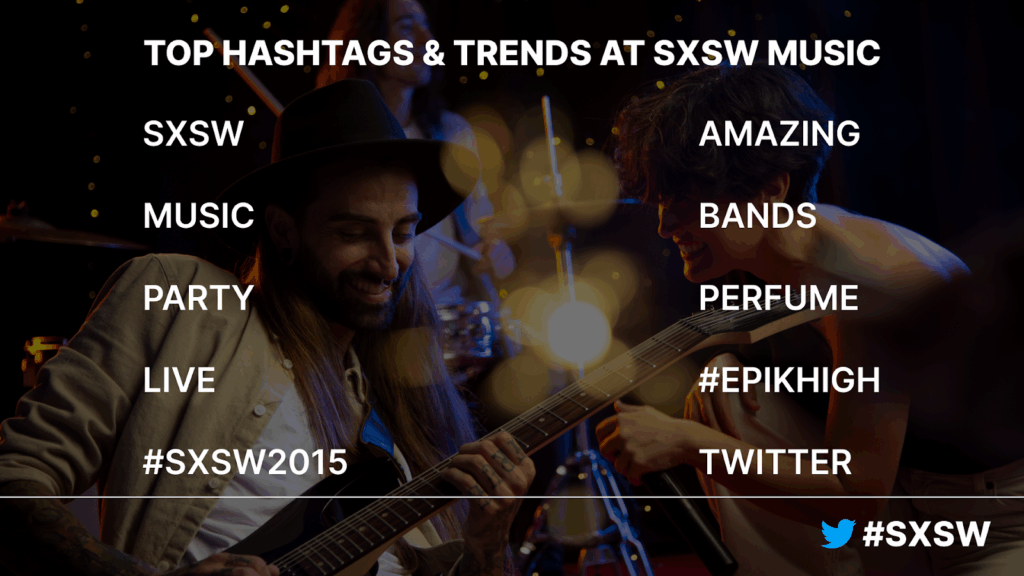
2.3 Prepare a Social Media Kit for Your Partners
Make it easy for partners, speakers, and sponsors to spread the word. Prepare a simple “social media kit” with ready-to-use graphics, sample posts, event details, your hashtag, and instructions or best practices for posting. This toolkit ensures everyone is sharing accurate information and keeps your branding consistent across the board. When your partners promote your event, their audiences take notice and your event gets a bigger spotlight.
Now that your event’s goals are set, your audience is defined, and your branding is locked in, it’s time to strategize social media marketing for your event into action.
How To Promote An Event On Social Media?
Promoting your event on social media is a carefully timed journey that unfolds in phases, each with its own tactics for building excitement, driving engagement, and keeping the momentum going from the first announcement to the final follow-up.
Here’s how to break it down for maximum impact:
Phase | Engagement & UGC | Live/Real-Time Content | Visual Content Sharing |
Before | Respond to inquiries, build anticipation, and encourage hashtag use | Host live Q&As, previews | Share graphics, teasers, and speaker promos |
During | Live engagement, share attendee content | Livestream sessions, post real-time updates | Post-event photos, videos, and highlights |
After | Thank, interact, and share attendee recaps | Share on-demand videos, event highlights | Repost UGC, infographics, and testimonials |
To ensure your event runs smoothly and keeps attendees engaged, consider using Wiz-Team’s Event-Works to manage everything from registration to real-time interaction.
13 Ways to Promote An Event on Social Media Before It Starts
A well-executed pre-event social media campaign can be the difference between a packed house and empty seats. Here are 13 expert strategies that go beyond the basics, drawing on proven tactics to maximize anticipation and attendance.
1. Optimize Social Profiles and Event Pages
Your social profiles and event landing pages should feature updated details, compelling visuals, and clear registration links. This not only builds credibility but also removes friction for potential attendees.
Here are some best practices to optimize social profiles and event pages:
Ensure all social profiles and event pages have up-to-date event details, including name, date, location, and schedule.
Use high-quality visuals and consistent branding to create a professional and trustworthy impression.
Feature clear, prominent registration links to make sign-ups easy and frictionless.
Include engaging bios and speaker information to inform and attract potential attendees.
2. Promote Your Event Hashtag
A memorable hashtag serves as the digital rallying point for your audience. When #Coachella trends, it’s not just because of the festival’s size; it’s the result of consistent, creative hashtag use across platforms.
3. Share Teasers, Behind-the-Scenes Content, and Speaker Features
Teaser campaigns and behind-the-scenes glimpses build intrigue and humanize the event. Highlighting keynote speakers or exclusive sessions drives shares and keeps audiences checking back for updates.
Here are some quick teaser ideas:
Countdown Graphics: Post daily or weekly countdowns to build anticipation.
Mystery Guest Reveals: Share blurred photos or cryptic clues about headline speakers or performers.
Behind-the-Scenes Clips: Show event setup, rehearsals, or sneak peeks of swag bags.
Speaker Soundbites: Post short video clips or quotes from featured speakers.
Exclusive Sneak Peeks: Tease special sessions, workshops, or activities without giving away full details.
To ensure your event operations are just as smooth behind the scenes as they are online, consider event management platforms like Wiz-Team that offer all-in-one solutions for registration, accreditation, and real-time data management.
4. Run Targeted Paid Ad Campaigns
Paid social advertising is essential for expanding reach beyond organic followers. Platforms like Facebook and Instagram allow for granular targeting by location, interests, or behavior, ensuring promotional budgets are spent reaching those most likely to attend.
To get the most out of targeted paid ad campaigns, follow these steps:
Choose the right platform: Facebook and Instagram for general audiences; LinkedIn for professional events; TikTok for younger crowds.
Create event-specific campaigns: Use Facebook Events Manager or Instagram Promotions to focus ads on your event, not just brand awareness.
Target your audience: Select interests like “live music” or “industry networking.” Build Lookalike Audiences from past attendees or followers.
Use compelling visuals: Short videos or striking images with date, time, and location upfront.
Optimize for results: Set objectives to “Event Responses,” “Conversions,” or “Website Traffic” to drive RSVPs and registrations.
5. Host Live Q&As, Previews, and Interactive Sessions
Live video content is proven to drive higher engagement rates. Hosting Q&As or event previews gives audiences direct access to organizers or speakers, answers burning questions, and creates a sense of exclusivity. Events like Comic-Con have used live streams to reveal special guests, generating immediate buzz and media coverage.
6. Understand Audience Interest with Social Polls
Polls encourage engagement by allowing people to share their opinions and help tailor your event to your audience’s preferences. Adding polls to Instagram Stories or LinkedIn can quickly reveal what potential attendees are most interested in.
Polls can be structured in two main ways:
Closed-ended polls (multiple choice) provide quick, quantifiable data. For example, asking, “Which speaker are you most excited to hear from?” helps you gauge popularity and adjust your promotion.
Open-ended polls allow users to share ideas, offering deeper feedback. Questions like “What would make this event unforgettable for you?” can uncover new content, partnership ideas, or marketing angles.
7. Initiate Contests, Giveaways
Contests and giveaways incentivize sharing and participation, turning your audience into active promoters of your event. To make this actionable:
Choose a relevant prize, like VIP tickets or exclusive merch.
Set clear rules (tagging friends, sharing posts, or using your hashtag).
Use a unique hashtag to track entries and boost visibility.
Partner with influencers to expand reach.
Announce winners publicly to build excitement and encourage future participation.
8. Offer Early Bird Discounts and Digital Incentives
Time-limited offers create urgency and reward early commitment. This tactic is a staple for conferences and ticketed events, where early bird pricing is paired with digital perks such as exclusive content or VIP access to boost registrations during the crucial pre-event window.
9. Collaborate with Influencers For Authentic Reach
Work with influencers whose audience and values align with your event’s mission. Focus on authenticity over follower count. Provide clear guidelines and creative freedom, allowing influencers to share your event story in their own voice, building trust, and driving engagement.
10. Encourage User-Generated Content (UGC)
Prompting attendees to share their RSVPs, anticipation, or creative takes using your hashtag not only builds excitement but also provides authentic content for your channels. Featuring UGC, as seen with #Eurovision fan posts and many others, generates a sense of belonging and amplifies organic reach.
11. Highlight Social Proof
Showcasing testimonials, notable attendees, or participating brands adds credibility and FOMO. When high-profile guests or respected companies are involved, their presence can sway undecided attendees. Social proof is a psychological trigger that’s especially powerful in event marketing.
12. Add Social Sharing Plug-ins to Your Website
Integrating social sharing buttons on event pages allows visitors to spread the word with a single click, turning every attendee into a potential promoter. This tactic is widely used by major ticketing platforms and event organizers to extend organic reach.
13. Spotlight Milestones and Countdowns
Marking milestones such as hitting registration targets or announcing new sponsors keeps momentum high. Countdown posts, especially as the event date approaches, build anticipation and remind audiences to secure their spot.
As your event shifts from anticipation to execution, this is the juncture where strategic preparation meets real-world engagement. This phase is critical, not just for amplifying live moments but for monitoring audience reactions and driving meaningful interaction as events happen.
5 Ways To Promote An Event While It Is Happening
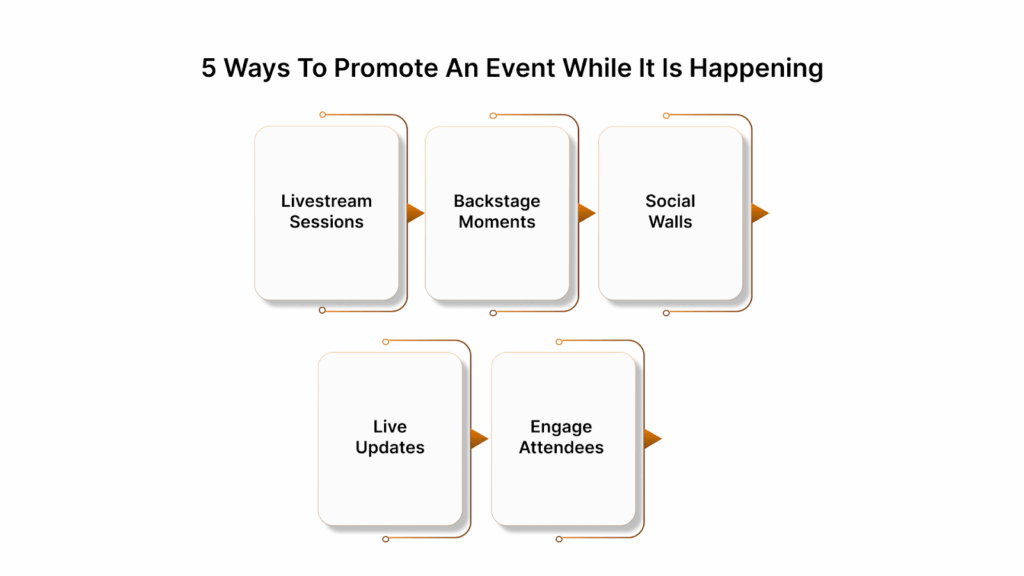
Make your event impossible to ignore while it’s happening. These five actionable tactics will help you capture attention in real time, engage both on-site and virtual attendees, and amplify your event’s impact across social channels.
1. Livestream Key Sessions, Panels, or Performances
Livestreaming is a powerful way to make your event accessible to a wider audience, including those who can’t attend in person. Platforms like YouTube Live, Facebook Live, or Instagram Live allow you to broadcast keynotes, panels, or performances in real time. Announce your Livestream schedule ahead of time and share direct links across your social channels to maximize participation.
The benefits go far beyond just accessibility:
Inspire Future Attendance: Up to 30% of people who watch a livestream event will attend in person the following year. This makes livestreaming a proven way to entice new attendees who might be undecided or unfamiliar with your event.
Real-Time Interaction: Encourage viewers to comment and ask questions during the stream.
Create Valuable Content: Your live stream can be archived and repurposed for future marketing, giving potential attendees a taste of what they missed and motivating them to join next time.
2. Highlight The Back-Stage Moments
Capture exclusive behind-the-scenes content such as interviews with speakers, glimpses of green rooms, or candid moments with performers. Sharing these raw, authentic snippets humanizes your event and offers followers unique content they can’t find elsewhere.
3. Social Media Walls and Stories for Real-Time UGC
Encourage attendees to become active participants by sharing their own event experiences on social media. User-generated content (UGC) is seen as more authentic and trustworthy than branded posts, as it comes directly from real attendees.
Set up photo ops: Create branded backdrops or selfie stations for shareable moments.
Promote your hashtag: Display it prominently so attendees can easily tag posts.
Showcase posts live: Feature attendee content on social media walls at the event.
Engage online: Like, comment, and reshare attendee posts to boost participation.
Schedule sharing breaks: Allow time between sessions for attendees to post.
4. Live-Tweet and Post Updates
Designate a team member to live-tweet or post updates during the event. Tag speakers, sponsors, and partners, and always use your official event hashtag to centralize the conversation.
Share key takeaways, sound bites, and images to build hype and reach people beyond your current attendees. This approach keeps your event top of mind and may even prompt last-minute participation.
5. Engage Actively with Both On-Site and Virtual Attendees
Monitor comments and messages across all channels, responding promptly to questions, shout-outs, or feedback. Share attendee posts, highlight virtual watch parties, and initiate live discussions to build a sense of community among both physical and remote participants.
So your event has ended, but promoting your event on social media does not have to end here. By continuing to share highlights, engage your audience, and spark new conversations, you keep the momentum alive. Let’s see how!
5 Ways To Promote An Event On Social Media After It Ends
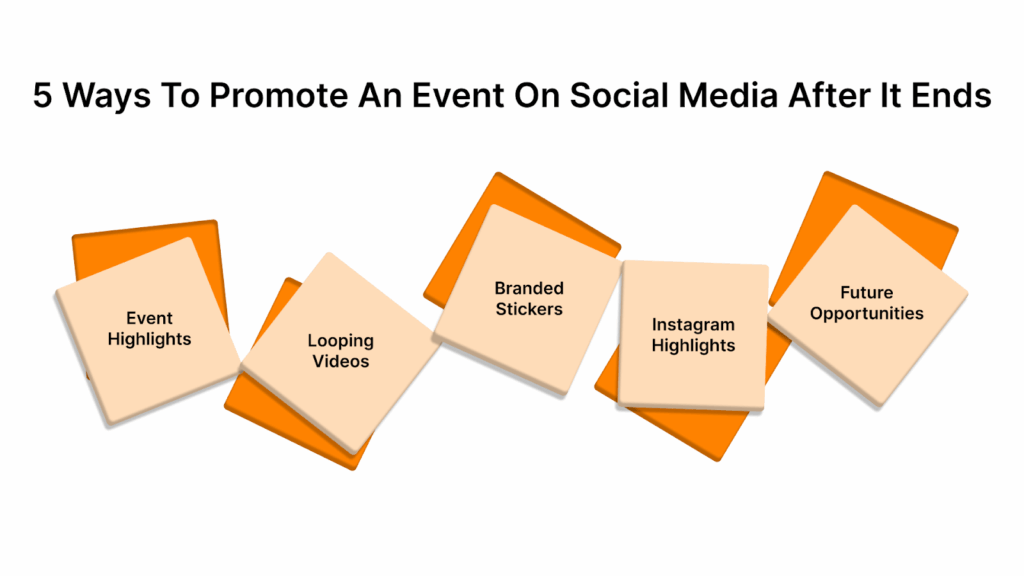
Keep the energy alive even after your event ends. Turn live moments into shareable content to keep your event on attendees’ minds and feeds, helping your audience stay connected.
1. Share Event Highlights
After the event, share highlight reels, photo galleries, and key moments to let attendees relive the experience and give others a preview of what they missed. This extends your event’s reach and reinforces its value..
2. Short-Form Looping Videos
Turn memorable moments into short, looping video clips with music or captions that are perfect for Instagram Reels, TikTok, or Facebook Stories. These can be more dynamic and engaging than static GIFs, capturing attention quickly and encouraging shares. For example, a speaker’s punchline or a crowd’s reaction can be looped with upbeat audio to amplify the mood.
3. Branded Animated Stickers or Emojis
Transform standout event visuals or inside jokes into custom stickers or emojis for use on Instagram Stories, WhatsApp, or Slack. These branded assets let your community express themselves while spreading your event identity organically.
4. Save Event Highlights to Instagram Highlights
Organizing your best event moments into Instagram Highlights ensures that the excitement and value of your event remain accessible long after it ends. Group Stories by themes, speakers, or sessions, and pin them to your profile. This evergreen content allows new followers and potential attendees to instantly experience the energy and quality of your event, serving as a dynamic showcase for your brand.
5. Announce Future Opportunities
Teasing upcoming events, early-bird offers, or new initiatives keeps your audience engaged and looking forward to what’s next. This creates a sense of anticipation and continuity, helping to convert one-time attendees into repeat participants.
As your event’s social media activity unfolds in real time, the next step is to move from execution to evaluation.
Measuring the Impact of Your Event’s Social Media
To truly grow and improve your events, it’s essential to move beyond gut feelings and use data-driven insights. By tracking the right metrics, you can clearly see what worked and what didn’t and how to deliver even better experiences next time.
Focus on a mix of quantitative and qualitative data to get a full picture of your event’s success:
Metric | Description |
Attendee Engagement | Monitor session participation, networking activity, messages sent, and social media interactions to gauge how involved your audience was. |
Feedback and Satisfaction | Use post-event surveys and satisfaction scores to capture attendee sentiment and gather actionable suggestions for improvement. |
Attendance and Registration | Analyze registration trends, actual turnout, and no-show rates to understand your event’s reach and identify gaps in your marketing or logistics. |
Sponsor and Partner Value | Track leads generated, brand visibility, and sponsor satisfaction to demonstrate ROI to your partners. |
Revenue and ROI | Calculate ticket sales, sponsorship revenue, and costs to assess your event’s financial performance and return on investment. |
Things To Be Aware Of While Promoting Your Event On Social Media
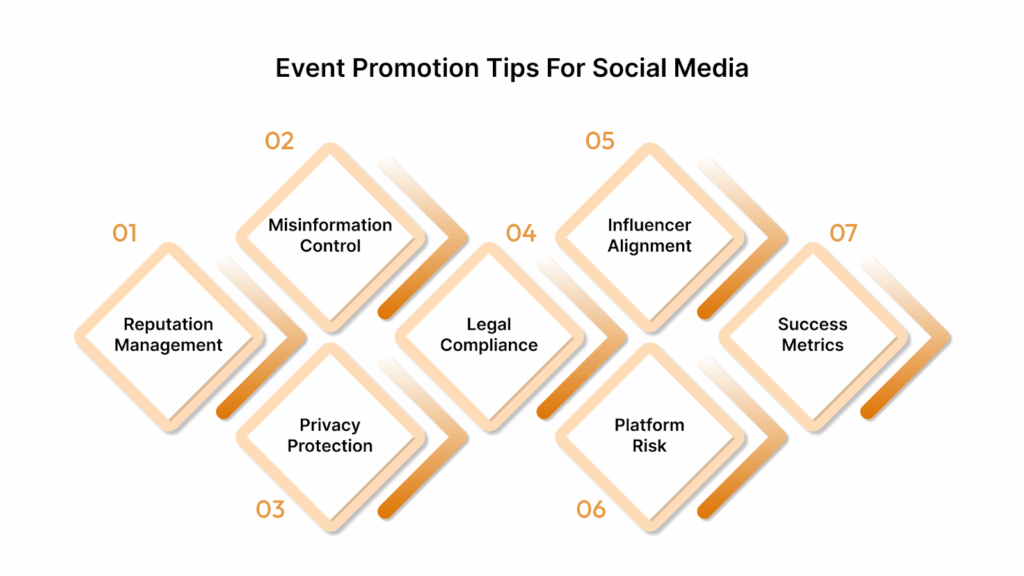
Being aware of potential risks ensures your strategy remains effective, transparent, and legally sound. Here are key considerations to keep in mind:
1. Your Reputation Is Always On the Line
One negative comment or misunderstanding can quickly escalate into a PR nightmare. Social media is unforgiving, and a poorly worded post can overshadow your efforts.
2. Misinformation Moves Faster Than You Think
False information can quickly spiral out of control. Stay on top of your channels and be ready to address any inaccuracies before they confuse or frustrate your audience.
3. Privacy Isn’t Just a Checkbox
Be sure to safeguard attendee information and respect consent when sharing photos, data, or lists. Even small privacy missteps can erode trust and cause legal issues.
To ensure you’re fully compliant with privacy regulations, consider using Wiz-Team’s Event-Works platform, which is GDPR-compliant and designed to keep attendee data secure.
4. Legal Landmines Are Everywhere
Make sure you have the proper rights for everything you share. Using unlicensed photos or music can bring unexpected legal trouble.
5. Negative Influencer Partnership
Choosing influencers who don’t align with your brand can backfire. Misalignment in values or audience can harm your event’s reputation and alienate your attendees.
6. Platform Dependency
Relying too heavily on one social platform is risky. Changes in algorithms or policies can reduce visibility and disrupt engagement strategies.
7. Measuring Success Isn’t Always Straightforward
Don’t just chase likes or shares. Without tracking meaningful metrics, it’s hard to gauge the true impact of your event or improve future efforts.
Conclusion
Social media is crowded, and attention spans are short. To cut through the noise, your event promotion strategy must be intentional, analytical, and adaptable. That means studying your audience, tracking what works, and being ready to pivot when needed. Brands and organizers who consistently win are those who approach event promotion on social media as a holistic, data-driven process. They don’t just chase likes; they build anticipation and encourage genuine engagement.
While social media promotion gets people excited, the real magic happens when your event runs smoothly from start to finish. That’s where event management platforms like Wiz-Team come in.
Wiz-Team’s Event Work is a modular platform that handles registrations manages VIP access and tracks real-time engagement.
Why consider Wiz-Team?
Trusted by global events for reliability and flexibility
Handles everything from registration to post-event analytics
Integrates easily with your favorite marketing and communication tools
Managed over 2million+ attendees in 2022 alone
If you are planning your next event, contact Wiz-Team to up your event success.
FAQs
Q1: How can I effectively promote an event on social media?
Utilize a mix of engaging content like countdowns, behind-the-scenes glimpses, and speaker highlights. Encourage user-generated content with a unique event hashtag and collaborate with influencers to expand your reach.
Q2: What are some cost-effective ways to promote an event?
Leverage organic channels such as social media platforms, email newsletters, and local community groups. Additionally, consider partnerships with local businesses or influencers to amplify your event’s visibility.
Q3: How do I create an event website to promote my event?
Use platforms like Wix or WordPress to build a dedicated event page. Include essential information such as event details, registration links, and a clear call to action to encourage sign-ups.
Q4: How can I measure the success of my event promotion efforts?
Track key performance indicators (KPIs) such as ticket sales, website traffic, social media engagement, and attendee feedback to evaluate the effectiveness of your promotional strategies.
Q5: How far in advance should I start promoting an event on social media?
Ideally, you should start promoting your event on social media at least 4-6 weeks in advance. This timeframe helps build anticipation and gives your audience enough time to engage with the content and register. For larger conferences or festivals, you might need 3–6 months, while smaller local events could be effectively promoted with less time.
#WizJourney
